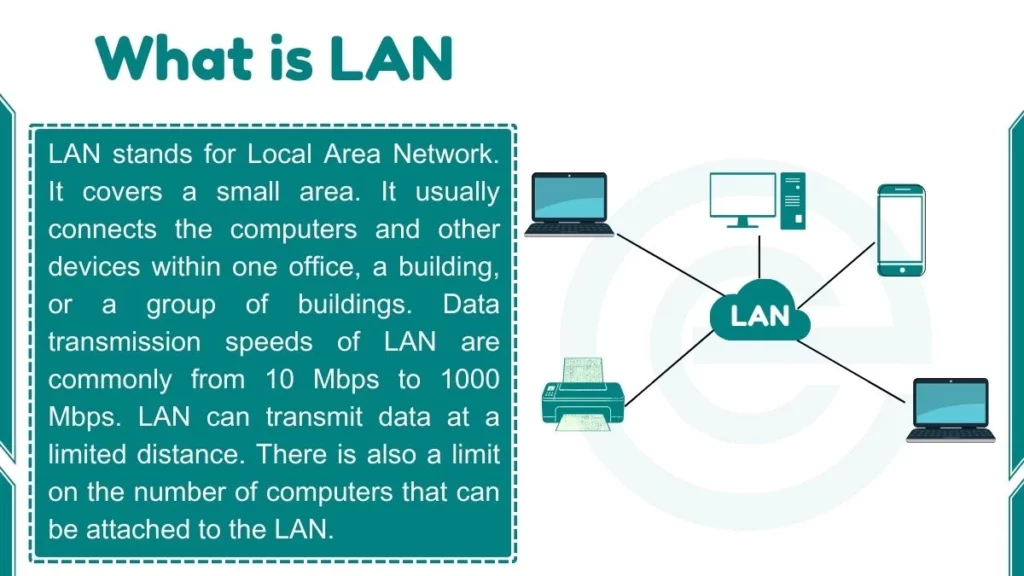LAN stands for Local Area Network. Local Area Network (LAN) is the most common type of computer network. It covers a small area. It usually connects the computers and other devices within one office, a building, or a group of buildings. LAN is used to share resources such as printers, hard disks, and programs.
LAN can transmit data very quickly. Data transmission speeds of LAN are commonly from 10 Mbps to 1000 Mbps. This is much faster than using old telephone lines. LAN can transmit data at a limited distance. There is also a limit on the number of computers that can be attached to the LAN.
Examples:
- Home network connecting devices like computers, phones, media players, printers, and smart home devices.
- Office building network linking employees’ computers, servers, printers, and other business equipment.
- School computer lab network enabling resource access and connectivity.

Advantages of LAN
Here are some benefits of LAN:
1. Resource Sharing: One of the main advantages of a LAN is the ability to share resources between connected devices. Resources like printers, file storage, software, and internet access can be shared by multiple users on the network. This enables efficiency and reduces costs.
2. Data Access: Files and folders stored on file servers and shared drives can be easily accessed from multiple computers and devices connected over the LAN. This improves collaboration and workflow.
3. Peripheral Sharing: Hardware peripherals like scanners, copiers, and printers can be connected directly to the LAN for use by any authorized device or user. This removes the need for separate equipment for each computer.
4. Communication: A LAN allows instant communication through messaging, video conferencing, and shared software tools. Users can collaborate in real-time, removing barriers and delays.
5. Security: Network administrators can implement security policies such as password protection, user permissions, antivirus tools, and firewalls. Data encryption across the LAN to protect sensitive resources and information.
Disadvantages LAN
Here are some drawbacks of LAN:
1. Single Point of Failure: If LAN hardware like the router, switch, or server fails connectivity for the entire network could fail. It causes overall disturbance.
2. Expense: The initial cost of cabling, network hardware, configuration, and installation can be high when setting up a LAN. The network needs consistent maintenance as well which has ongoing costs.
3. Limited Scalability: Due to distance and device limitations, LANs may not scale well beyond a certain office, building, or campus size compared to larger network types like WANs (Wide Area Networks). Expanding may require additional investments.
Connecting devices in a LAN
There are two primary methods used for connecting devices to create a Local Area Network – wired and wireless.
1. wired: Wired LANs use Ethernet cable to physically connect devices to the network using switches, hubs, and routers. This offers reliable high speeds and security.
2. Wireless: Wireless LANs (WLANs) connect devices using WiFi and radio wave transmission. This enables more flexibility and mobility as cables are not required to add additional devices.
Distance and Device Limits
While the fast transmission speeds of Local Area Networks allow efficient communication. There are physical limitations:
- Distance is limited based on the signal strengths from cables or wireless transmission. Longer distances weaken signals and slow speeds.
- The number of devices a LAN can support also depends on the standard being used and the capability of connected hardware like routers and switches. More powerful enterprise equipment can handle additional devices.
Also Read:
